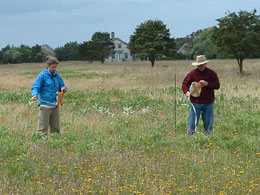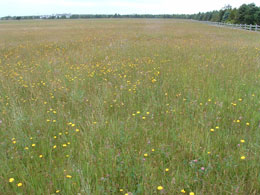 |

For further information, contact the MBL Communications Office at (508) 289-7423 or e-mail us at comm@mbl.edu
Embargoed For Print/Broadcast
Until 9:00 AM August 3, 2007
Contact: Gina Hebert, MBL, 508-289-7725; ghebert@mbl.edu
Restoration Of Globally-Rare Sandplains To Begin On Martha’s Vineyard
 |
|
 |
Resources
Photos: Click on thumbnails for larger images

Scientists collect baseline information on soils and plant composition at the Bamford Preserve on Martha’s Vineyard. Photo Credit: Chris Neill

Martha’s Vineyard sandplain grasslands and shrublands are globally-important hotspots for biodiversity. Photo Credit: Chris Neill
Additional Background:
|
Project could lead to region-wide restoration, reducing threat to dozens of species
August 3, 2007 (Vineyard Haven, Mass.) – In an effort to prevent the loss of the Vineyard's native sandplain communities, the MBL (Marine Biological Laboratory) and The Nature Conservancy have launched an innovative restoration program on the Conservancy’s newly-dedicated Bamford Preserve at Herring Creek Farm.
The five-year pilot project – funded through a gift by lifelong summer resident Roger Bamford – will test methods to restore the agricultural field at Herring Creek to the species-rich sandplain grasslands and shrublands, which currently exist only in pockets of the Northeast.
Insights gained from these tests can then be used across the region to restore these native communities over a much broader landscape, with the goal of bringing them – and the rare species they harbor – back from the edge of extinction.
"Sandplain communities contain an incredibly rich assemblage of rare plant species and attract a diversity of birds, butterflies and moths," said Wayne Klockner, The Nature Conservancy's Massachusetts State Director. "When the country's first red-footed falcon ended up on the Vineyard in 2004, he found refuge in the grasslands at Katama Airfield. Because there are so few of these areas left, this effort to restore former pastures to the original sandplains – in a way that can be replicated off the island – is a tremendous opportunity to save these species on a regional scale."
Open sandplain communities are home to more than 20 plant species – such as sandplain gerardia and bushy rockrose – that are endangered, threatened, of special concern or in decline throughout the region. They also support several species of birds that are rare or declining in the Northeast, like Northern Harriers, Short-eared Owls and Grasshopper Sparrows.
Restoring formerly plowed agricultural lands to native sandplain communities is a considerable challenge; soils and vegetation are substantially modified by agricultural activities and are much more fertile than those of sandplain communities. This can be a barrier to successful restoration of native sandplain plants, as fertile soils favor non-native plants while native species have adapted to and thrived in dry, nutrient poor soils.
To meet this challenge, MBL and the Conservancy will test a variety of soil treatments aimed at reducing soil fertility and seeding treatments designed to establish a diverse native plant community. Collection of baseline information on soils and plant composition began in June on 180 separate plots. The most successful techniques will then be applied to larger areas of the preserve over the next several years.
"This experiment will be an important source of practical information that will guide establishment of endangered sandplain communities from Long Island to Maine," said Christopher Neill, an ecologist in the MBL's Ecosystems Center, who leads the collection of scientific information, "but it will also test larger ideas about how former land use and the enrichment of land by fertilizer and widespread deposition of nitrogen can subtly tip the ecological balance between native and non-native species. These are critical issues for conservation of species-rich and rare plant communities worldwide."
The Bamford Preserve is located on the East Field of Herring Creek Farm, which the Conservancy purchased in 2001. Because the field abuts the existing sandplain grasslands at Katama, its restoration will create the largest contiguous block of high-quality sandplain grassland and shrubland in the Northeast. Connecting these natural areas helps to increase the species diversity of sandplain communities in the region and will make the grasslands more resilient and better able to persist in the face of climate change.
The MBL® is a leading international, independent, nonprofit institution dedicated to discovery and to improving the human condition through creative research and education in the biological, biomedical and environmental sciences. Founded in 1888 as the Marine Biological Laboratory, the MBL is the oldest private marine laboratory in the Western Hemisphere. For more information, visit www.MBL.edu.
The Nature Conservancy is a leading conservation organization working around the world to protect ecologically important lands and waters for nature and people. To date, the Conservancy and its more than one million members have been responsible for the protection of more than 15 million acres in the United States and have helped preserve more than 102 million acres in Latin America, the Caribbean, Asia and the Pacific. Visit The Nature Conservancy on the Web at www.nature.org.
|